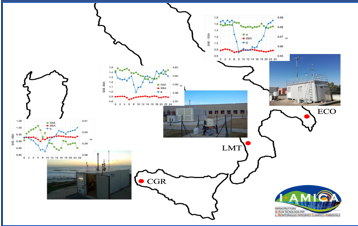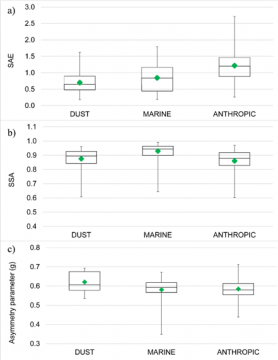Characterization of In Situ Aerosol Optical Properties in the Central Mediterranean
j F Y in In Evidenza, Notizie
Pubblicato su Atmosphere 2018, 9, 369; doi:10.3390/atmos9100369 il lavoro che riguarda lo studio delle proprietà ottiche del particolato misurate presso gli Osservatori I-AMICA di Lecce, Lamezia Terme e Capo Granitola. Le proprietà ottiche del particolato sono state caratterizzate per un mese di misura (Aprile 2016) relativamente a tre diverse tipologie di aerosol (polveri sahariane, marino ed antropico).
Autori: Antonio Donateo, Teresa Lo Feudo, Angela Marinoni, Adelaide Dinoi, Elenio Avolio, Eva Merico, Claudia R. Calidonna, Daniele Contini and Paolo Bonasoni.
Contatti: Antonio Donateo, a.donateo@isac.cnr.it
Per scaricare l’articolo seleziona il Titolo.
In this work, results of scattering and backscattering coefficients, scattering Ångström exponent (SAE), single scattering albedo (SSA), and asymmetry parameter (g) of atmospheric aerosols are presented. All these parameters were measured during the month of April 2016 in Southern Italy on three different Global Atmosphere Watch observatories in the Central Mediterranean. This is the first time, to our knowledge, that optical aerosol properties were studied at the same time, even if in a brief intensive measurement campaign, at three sites in the South of Italy. In order to obtain a characteristic value for aerosol optical properties, different kinds of particle sources (i.e., dust, marine, and anthropic) have been identified and studied. In the measurement period, one event of a long-range transport of Saharan dust from Northern Africa was observed at all observatories. During the Saharan dust transport event, a minimum value of the SAE (0.69 ± 0.34) and a relatively higher values of SSA were observed. During the dust event, g increased up to 0.69. Marine aerosol contribution and anthropic/urban aerosol intrusion were analysed. From this analysis, SAE average values were 0.70, 0.84, and 1.22, respectively, for dust, marine, and anthropic particles. On the other hand, the SSA minimum value was 0.86 for anthropic particles, and it increased for dust (0.88) and marine (0.93) aerosols. The asymmetry parameter had a limited variability for the three types of aerosol from 0.62 to 0.58, as reported also in literature.








